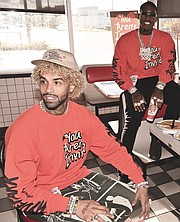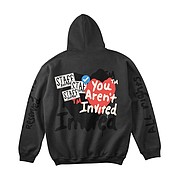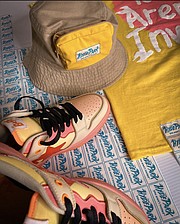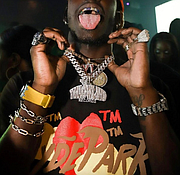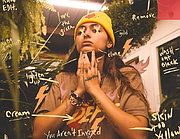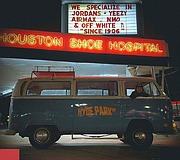10/18/2022

From the brain of a graffiti artist, break-dancer, and graphic designer to now being one of the most recognized, newly developed brands throughout the nation, Hyde Park Goods is a fashion-forward American clothing empire that is creating its own niche in the fashion industry.
Meet Jacob Joseph, the creative force behind the brand and founder/owner of Hyde Park Recreation Center. With over a decade in the apparel and print industries, he has had the opportunity to work with Fortune 500 companies, local non-profits, and influencers with large audiences, and is now creating his own path with Hyde Park headquartered in Houston, TX,
At its core, Hyde Park is a group of rebels, creatives, and visionaries who embody play and redefine how creatives impact culture. The brand caters to the creative community and produces signature clothes and accessories and collaborations with other brands and content creators.
Known for its focus on capturing authenticity, providing quality, and consistently innovating the brand has been seen worn by celebrities including Actor Tyler Lepley, Rapper Jeezy, Rapper Glorilla, Rapper, Saucy Santana, and Comedian DC Young Fly to name a few.
I [Reggie Dominique] caught up with designer Jacob Joseph to discuss the vision, launch, and passion behind his groundbreaking collection and here is what he had to say:
RD: For those who may not be familiar, introduce yourself to our readers.
JJ: Hyde Park Jacob. Designer, artist, and creative entrepreneur.
RD: How long have you been in the fashion industry as a designer?
JJ: Hyde Park has been around for a year and a half now, but in total, a long time. In the beginning, more tangentially. My art journey started through hip-hop culture in the mid-to-late-90s. I had gone to this park by my house one day to practice breakdance, and they just so happened to be this guy from Chicago, he was maybe like two years older, and he was pop-locking and was sketching in a black book. I didn’t know what graffiti was then, and he turned me onto that. I would’ve never been here in this position if I had never been introduced to that person. What he showed me in that book was NY/Chicago, bombing or “throwies/throw-ups,” wildstyle. He told me graffiti was the language you wrote in hip-hop culture. If dancing was a way to express yourself and rap was what you listened to, then graffiti was like hip-hop's written communication. It unlocked a whole new world for me. From that point, I was a breakdancer and a graffiti artist.
I was in 2 crews, which the city and state determined to be gang-related. They identified us as gang members, but I was so young and the world was so small that I couldn’t comprehend what that meant. So I kept getting thrown in jail. I couldn’t understand why because I was making art. Because of my affiliation with these activities, I was profiled as a gang member. Guilty by association. Does it quack like a duck? Does it look like a duck? Wearing baggy pants, hanging out in groups of people walking around on the street with a boombox, we listened to rap; we carried spray paint everywhere. People were locking their doors when we walked by. It was crazy.
I taught myself graphic design, which turned into working with Fortune 500 companies and people asking me to design their apparel. I started creating for several social media influencers and helping them build an apparel revenue stream from the ground up.
I helped a lot of people, but at what expense? Doing projects for other people killed my soul. I wanted to get back to my roots. So Hyde Park was born.
RD: How did you come up with the concept of Hyde Park Goods?
JJ: Many talented people don’t have a chance to get rich or famous. Over the past decade, I realized social media would cause people to seek attention or approval from others. Even in my own experience, I could see that. I wanted to make Hyde Park a passion project–not to make money but to express myself creatively, but how I saw the world of people always trying to captivate and get noticed. This concept is like taking power back and saying, “I don’t care what you think. I’m doing what I want to do with my life”. The pendulum is swinging back. A whole group of people doesn’t want that, and I wanted to use that as a basis for Hyde Park.
During the pandemic, I had a lot of time to reflect. I am notoriously bad at staying put. I always have to be doing multiple things at once. If you tell me something, my brain connects the dots. I can’t sit through a lecture–I’m trying the next idea out the door. That’s pretty much what happened. I was miserable doing nothing, and at the same time, I had helped launch and curate all these other successful brands, so it was kind of like all my creative restlessness just came bursting out, and I had to go with it.
RD: We love the trendy & fashion-forward prints in your collections; tell us about their inspiration and design process.
JJ: I don’t know about trendy. Trends or fads are items that accumulate overnight attention but have little surviving power. Not wasting much time chasing squirrels is essential and allows me to be free creatively.
RD: Where are the clothes and accessories available for purchase?
JJ: Mostly on our website through monthly drops, where people have shown love from London, Tokyo, etc. And you have to have the password to shop.
We’re also in approximately 60+ stores across the U.S., with some international interest growing, which is exciting. But yeah, you’ll need to figure out where those stores are because we do not have a public list of stores.
RD: As a creative, in your opinion – what makes Hyde Park Goods uniquely different from other up-and-coming brands?
JJ: From a mechanics point of view, I don’t think many streetwear brands do everything in-house. The design, printing, sewing, fulfillment, distribution, marketing, sales, and finance–it’s all in-house. For example, I hand-draw everything, so you won’t find our font out there unless it’s been stolen.
From a more humanistic point of view, it’s simply connecting with and nurturing a relationship with someone over time. The early years are about building the foundation of a brand’s legacy.
I like to hire makers, dreamers, creatives, and people who love making things with their hands and are part of the culture. We’re not just hiring an ad agency to target the hip-hop culture to sell a product. We’re pushing forward new ideas and perceptions.
RD: What motivates you the most about having your own fashion business?
JJ: Definitely freedom. Freedom to pursue the boldest and most creative act. There’s this concept in property appraisal called “highest and best use .”My art is the highest and best use of what I can do for the world.
RD: The designs you created are no doubt good enough, but who and which things were your inspiration while creating such designs?
JJ: Inspiration can come from anywhere. The most important thing –and I want to emphasize just how vital this is–is to have fun. I’ll stop if it’s not fun anymore.
RD: Do you think the ever-increasing number of overseas brands coming to America threatens local designers?
JJ: I look at things globally. There’s enough space for everyone to work together. I don’t do a lot of collaborations, but that might change in the future if the timing works out. I think there are more ways more prominent people and smaller people can do collaborations. We can all lift each other as long as we’re putting out a meaningful product and it’s impactful. We need different viewpoints. From a large-scale, biological perspective, there are pros to surviving if you’ve got diversity. But also, just for the sake of making life enjoyable. Some of the most thought-provoking art that has stood the test of time has come from organic yet highly unusual experiences.
RD: Hyde Park is described as a brand capturing authenticity, providing quality, and consistently innovating. Where do you see Hyde Park in 10 years?
JJ: We have a few things cookin’ in the kitchen, but I can’t spill anything quite yet. Just know that you’ll look back on this interview one day and think, “Hot damn! They changed some shit up in the culture.”
Hyde Park releases new products in 70 hype stores worldwide and on its website. We also regularly host creative meetups, workshops, and pop-ups, building a more engaged and loyal community.
The brand also has an in-house system for distributing content and merchandise, leveraging its 1971 Volkswagen bus for in-person, experiential events and its YouTube and Instagram channels, which
showcase the journey of building a brand.
For more on Hyde Park Goods visit: www.hydeparkgoods.com (but make sure you have the password 🔐)
Special thanks to Kevin Scott, Public Relations for Hyde Park Goods.

